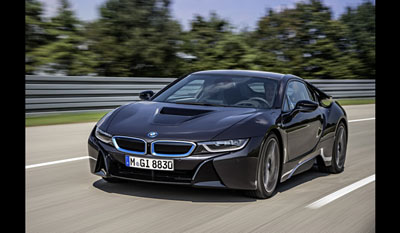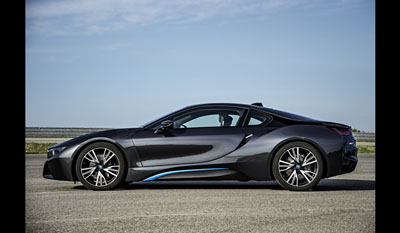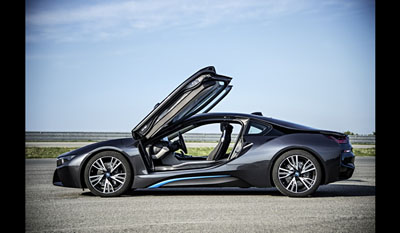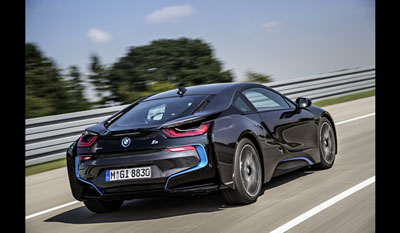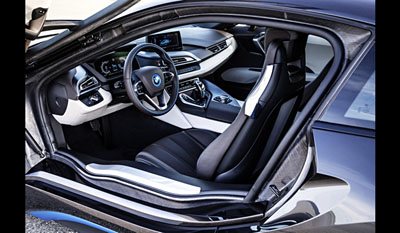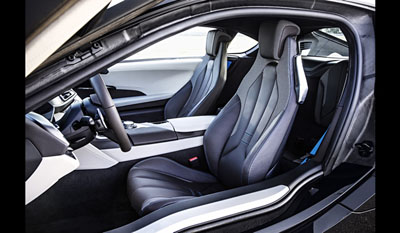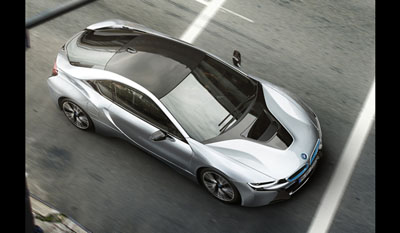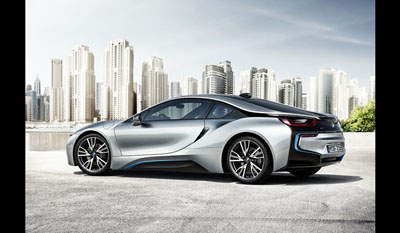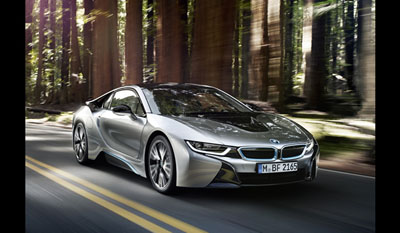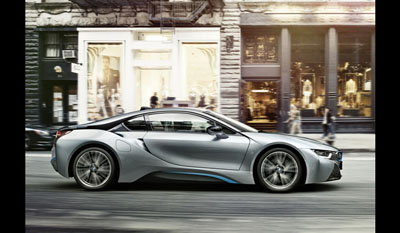BMW i8 Plug-in Hybrid Sports Car 2013
The BMW i8 is the second product of the BMW i brand dedicated to electric drive. The BMW i8 was first introduced in 2011 as a concept car. It is now introduced at the 2013 IAA Frankfurt Motor show as a production ready proposal and will be introduced on the market in early 2014. The plug-in hybrid system of the BMW i8 combines the first highly-turbocharged three-cylinder BMW TwinPower Turbo petrol engine to be fitted in a series-produced model with BMW eDrive technology in the form of an electric drive system likewise developed by the BMW Group. The 1.5-litre combustion engine develops 170 kW/231 hp and drives the rear wheels of the BMW i8. The 96 kW/131 hp electric motor sends its power to the front wheels and allows an all-electric range of up to 35 kilometres (22 miles) and a top speed of 120 km/h (75 mph). The motor draws its energy from a lithium-ion battery which can be charged from a conventional domestic power socket, a BMW i Wallbox or a public charging station. With the overall concept of a plug-in hybrid drive system, precise management of all the car’s energy streams and intelligent lightweight design, the BMW i8 represents a new stage in the Efficient Dynamics development strategy.
The combined use of an electric motor and a combustion engine and the specific set-up of the BMW i8 hybrid system to accentuate the properties of the car’s rear-wheel drive provide a road-biased all-wheel-drive experience headlined by powerful acceleration and dynamics-focused power distribution through keenly taken corners. In addition to impressive sportiness, the intelligent drive management of the BMW i8 also ensures outstanding efficiency. Its overall concept, design and drive system technology make the BMW i8 the world’s most forward-looking model in the sports car segment. It combines the performance-related attributes of a powerful sports car with fuel consumption and emissions more readily associated with a small car, an inspirationally progressive exterior and interior design, and a DIN kerb weight of less than 1,490 kilograms. The all-encompassing approach of the BMW i brand also includes the extensive use of recycled materials, renewable raw materials and naturally treated materials, alongside extremely resource-efficient production methods.
The BMW i8 was purpose-designed as a plug-in hybrid sports car with agile performance attributes and exceptional efficiency, and features a bespoke version of the LifeDrive architecture developed for BMW i cars. The combustion engine and electric motor, battery pack, power electronics, chassis components and structural and crash functions are arranged together in the aluminium Drive module, while the central element of the Life module is the CFRP passenger cell. The vehicle structure and materials of the 2+2-seater allow a new dimension in weight optimisation. They also give the car an extremely low centre of gravity, at under 460 millimetres, and a virtually 50 : 50 distribution of weight between the front and rear axles, enhancing the agile handling of the BMW i8. A length of 4,689 millimetres, width of 1,942 millimetres and height of 1,293 millimetres give the BMW i8 typical sports car proportions. Its dynamic character is also reflected in its long bonnet, clearly visible aerodynamic aids, stretched roofline, short overhangs and long, 2,800-millimetre wheelbase. The groundbreaking combination of sporting ability and efficiency is translated into the design of the 2+2-seater with intoxicating élan – and with the signature BMW i design language at the fore. The BMW i8 boasts a drag coefficient (Cd) of 0.26 and a fine aerodynamic balance. The low-slung bonnet, almost totally blanked off kidney grille, Air Curtains in the front apron, sealed underbody, contoured side skirts, “stream flow” lines of the car’s flanks, air ducts between the rear lights and roof frame and diffuser in the rear apron allow the air to be channelled extremely effectively as it hits the car. Precisely defined airflow across all areas of the body provides a balance between air resistance and lift designed to maximise driving dynamics and directional stability. The design of the BMW i8 body is as groundbreaking as the plug-in hybrid sports car’s concept as a whole. Hallmark BMW dynamics, lightweight design and efficiency are all expressed in the car’s proportions, lines and surface design. The 2+2-seater is immediately recognisable as a BMW i model and a new generation sports car. The design language developed specifically for BMW i cars and the freedom in terms of body design opened up by the LifeDrive architecture produce an end result which authentically reflects the sporting characteristics of the BMW i8, its innovative premium character and its future-focused technology. The structure of overlapping and interlocking surfaces – lent additional emphasis by the car’s colour concept – also contributes to the unmistakable appearance of the BMW i8. This layering principle allows aerodynamic forms to be wrapped up in a progressively styled package, while powerfully formed wheel arches draw attention to the wide track of the BMW i8. The compact construction distinguishing both the electric motor and combustion engine allows the front and rear sections of the car to be particularly low-slung and thus accentuate the car’s dynamically stretched flanks. The doors, which open forwards and upwards like wings, add extra intrigue to the sports car design of the BMW i8.
A signature feature of BMW i cars is the “black belt”. On the BMW i8, it emerges in a “V” shape from the bonnet and extends back over the roof into the rear section of the car, where it frames the centre section of the rear apron. At the front end, the black belt is framed by the body-coloured front apron and side panels, while at the rear it is overlapped by the “floating” roof pillars, which extend over the rear lights. Another element of the standalone BMW i design language is the “stream flow” contour of the side window graphic. On the BMW i8, the stream flow also determines the path travelled by the air between the falling roofline and the character line rising through the rear section of the car’s flanks towards the rear spoiler lip. With its combination of the aluminium Drive module and the CFRP passenger cell (Life module), the BMW i8 is also an excellent example of intelligent lightweight design – one of the guiding principles of the Efficient Dynamics strategy. Use of the lightweight high-tech material CFRP, which also offers excellent crash performance, brings weight savings of 50 per cent over steel and around 30 per cent over aluminium. The BMW i8 an unladen weight of less than 1,490 kilograms. The LifeDrive architecture also brings benefits in terms of weight distribution. The battery pack is situated low down in the middle of the vehicle, resulting in a low and central centre of gravity, which improves safety. No other current model of a BMW Group brand has such a low centre of gravity. The front-rear axle load distribution maximises agility with a near-perfect 50:50 axle load ratio. The compact electric motor, together with the transmission and power electronics, are situated in close proximity to the electrically powered front axle. The highly turbocharged petrol engine, which is located together with its transmission in the rear of the BMW i8, likewise sends its power to the road via the shortest possible route, i.e. through the rear wheels. As a finishing touch to this excellent weight distribution, the lithium-ion battery pack is centrally located in the vehicle, slightly forward of the mid-point. In terms of crash safety, this is an ideal location for the battery, which is integrated in an aluminium housing. The doors comprise a CFRP inner structure and an aluminium outer skin. This reduces the weight of the door by 50 per cent compared with a conventional design. The intelligent design of the magnesium instrument panel support brings a weight saving of around 30 per cent compared with the BMW 6 Series, for example. In addition, the high structural rigidity of the magnesium support provides a strengthening effect which allows the number of components to be reduced, thereby lowering weight by a further10 per cent. Innovative foam plastic technology used in the air conditioning ducts brings 60 per cent weight savings over conventional components, while also improving acoustics thanks to its sound-absorbing properties. Moreover, the fact that the power electronics and electric motor are directly connected reduces the amount of wiring required, while partial use of aluminium wiring brings further weight reductions. The BMW i8 is also the world’s first volume-produced vehicle to be equipped with chemically hardened glass. This innovative technology, to date used mainly in Smartphone manufacturing, results in very high strength. The partition between the passenger compartment and boot of the BMW i8 consists of two layers of chemically hardened glass, each of which is just 0.7 millimetres thick, with acoustic sheeting sandwiched between. In addition to excellent acoustic properties, a further advantage of this solution is weight savings of around 50 per cent compared with conventional laminated glass. The plug-in hybrid system of the BMW i8, which comprises a BMW TwinPower Turbo engine combined with BMW eDrive technology, offers the best of both worlds: excellent potential for improved efficiency and exciting, sporty driving characteristics. The BMW Group has developed not only the internal combustion engine and electric motor in-house but also the power electronics and the battery. This ensures that all these components offer high product and quality standards, based on the outstanding capabilities of the BMW Group in the field of powertrain research and development. The revolutionary character of the BMW i8 is emphasised by a further innovation: the use of a new internal combustion engine which is making its debut in this model. The BMW i8 is the first BMW production model to be powered by a three-cylinder petrol engine. This highly turbocharged unit is equipped with latest-generation BMW TwinPower Turbo technology. It is exceptionally compact and develops maximum power of 170 kW/231 hp. The resulting specific output of 113 kW/154 hp per litre of displacement is on a par with high-performance sports car engines and is the highest of any engine produced by the BMW Group.
The new three-cylinder engine derives its typical characteristics from the BMW six-cylinder in-line engines, to which it is closely related and which are noted for their eager power delivery, revving ability and refinement. The three-cylinder’s BMW TwinPower Turbo technology comprises a high-performance turbocharging system and direct petrol injection with high-precision injectors positioned between the valves, along with VALVETRONIC throttle-less load control, which improves efficiency and response thanks to seamlessly variable valve lift control. The three-cylinder unit responds instantly to the slightest touch of the accelerator pedal and soon reaches its maximum torque of 320 Newton metres. Like a six-cylinder engine, the three-cylinder unit is free of first and second order inertial forces. The low roll torque, a typical feature of a three-cylinder design, is further reduced by a balancer shaft. Its second power source is a hybrid synchronous electric motor specially developed and produced by the BMW Group for the BMW i8. The electric motor develops maximum power of 96 kW/131 hp and produces its maximum torque of around 250 Newton metres from standstill. Typical of an electric motor, responsive power is instantly available when starting and this continues into the higher load ranges. The linear power delivery, which extends right up to the high end of the rpm range, is down to a special motor design principle exclusive to BMW i. BMW eDrive technology refines and improves on the principle of the permanently excited synchronous motor via a special arrangement and size of the torque-producing components. This results in a self-magnetising effect normally confined to reluctance motors. This additional excitation ensures that the electromechanical field generated when current is applied remains stable even at high rpm. As well as providing a power boost to assist the petrol engine during acceleration, the electric motor can also power the vehicle by itself. Top speed is then 120 km/h (approx. 75 mph). The BMW i8 has a maximum driving range in this emission-free, virtually soundless, all-electric mode of up to 35 kilometres (approx. 22 miles). The motor derives its energy from the lithium-ion battery which is centrally mounted underneath the floor of the vehicle. The model-specific version of the high-voltage battery was developed and produced by the BMW Group. It has a liquid cooling system, delivers a maximum usable capacity of five kilowatt-hours and can be recharged at a conventional household power socket, at a BMW i Wallbox or at a public charging station. A full recharge takes less than three hours at a household power socket and less than two hours at a BMW i Wallbox. The BMW i8’s vehicle concept and powertrain control system mark it out as a progressive, revolutionary sports car. The BMW i8 always achieves the optimal balance between performance and efficiency, whatever the driving situation. Energy for the high-voltage battery can be generated via the electric motor during overrun. Furthermore, when power demands allow, the high-voltage battery is recharged by the electric motor. The high-voltage starter-generator, responsible for starting the engine, can also be used as a generator to charge the battery, the necessary power being provided by the BMW TwinPower Turbo engine. These processes help to prevent depletion of the BMW i8’s battery in order to maintain the electric drive power. The all-electric driving range is sufficient to cover most urban driving requirements. Out of town, the BMW i8 offers impressively sporty performance which is also very efficient thanks to the power-boosting support for the petrol engine from the electric motor. With such versatility, the BMW i8 belongs to a new generation of sports cars which unites exciting performance with cutting-edge efficiency – to enhance both driving pleasure and sustainability. The rear wheels of the BMW i8 are driven by the petrol engine via a six-speed automatic transmission. The front wheels are driven by the electric motor via a two-stage automatic transmission. Combined maximum power and torque of 266 kW/362 hp and 570 Newton metres respectively provide all-wheel-drive performance which is as dynamic as it is efficient. The BMW i8’s intelligent powertrain control system ensures perfect coordination of both power sources. The variable power-sharing between the internal combustion engine and the electric motor makes the driver aware of the sporty temperament of the BMW i8 at all times, while at the same time maximising the energy efficiency of the overall system. The BMW i8 has an electronically controlled top speed of 250 km/h (155 mph), which can be reached and maintained when the vehicle operates solely on the petrol engine. Variable front-rear power splitting in line with changing driving conditions makes for excitingly dynamic cornering. On entering the corner, the power split is biased towards the rear wheels to improve turning precision. For more vigorous acceleration out of the corner, the powertrain controller returns to the default split as soon as the steering angle becomes smaller again. The BMW i8 offers the driver unusual scope to adjust the drive and suspension settings of the vehicle in order to adapt the driving experience to his or her individual preferences. As well as the electronic gear selector for the automatic transmission, the driver can also use the Driving Experience Control switch – a familiar feature of the latest BMW models – or, exclusively to the BMW i8, the eDrive button. It gives the driver five operating modes to choose from: D for automated gear selection in COMFORT and ECO PRO mode, SPORT mode and purely electric driving in eDrive mode, likewise with a choice of COMFORT and ECO PRO mode. The Driving Experience Control switch on the centre console offers a choice of two settings. On starting, COMFORT mode is activated, which offers a balance between sporty performance and fuel efficiency, with unrestricted access to all convenience functions. Alternatively, at the touch of a button, ECO PRO mode can be engaged, which, on the BMW i8 as on other models, supports an efficiency-optimised driving style. The powertrain controller coordinates the cooperation between the petrol engine and the electric motor for maximum fuel economy. On overrun, the intelligent energy management system automatically decides, in line with the driving situation and vehicle status, whether to recuperate braking energy or to coast with the powertrain disengaged. At the same time, ECO PRO mode also programs electrical convenience functions such as the air conditioning, seat heating and heated mirrors to operate at minimum power consumption – but without compromising safety. The maximum driving range of the BMW i8 on a full fuel tank and with a fully charged battery is over 500 kilometres (310 miles) in COMFORT mode. SPORT mode offers sequential manual gear selection and at the same time switches to very sporty drive and suspension settings. In SPORT mode, the engine and electric motor deliver extra-sharp performance, accelerator response is faster and the power boost from the electric motor is maximised. And to keep the battery topped up, SPORT mode also activates maximum energy recuperation during overrun and braking. If the battery is recharged using kinetic energy, the electric motor’s generator function switches to a more powerful setting. At the same time, gear change times are shortened and an extra-sporty setting is selected for the standard-fitted Dynamic Damper Control. The BMW i8’s ECO PRO mode can also be used during all-electric operation. The vehicle is then powered solely by the electric motor. Only if the battery charge drops below a given level, or under sudden intense throttle application (kickdown), is the internal combustion engine automatically activated. The high-end chassis and suspension technology of the BMW i8 is based on a double-track control arm front axle and a five-link rear axle, whose aluminium components and geometry are specially configured for intelligent weight savings. The electromechanical power steering offers easy manoeuvring in town and typical sports car-style high-speed steering precision. Also standard is Dynamic Damper Control: the electronically operated dampers change their characteristics according to the selected driving mode to deliver the desired vehicle dynamics. The DSC (Dynamic Stability Control) stability system includes the Anti-lock Braking System (ABS), Cornering Brake Control (CBC), Dynamic Brake Control (DBC), Brake Assist, Brake Standby, Start-Off Assistant, Fading Compensation and the Brake Drying function. The push button-activated Dynamic Traction Control (DTC) system raises the DSC thresholds, allowing some controlled drive wheel slippage for easier start-off on snow or loose ground, or for extra-dynamic cornering. The specially adapted version of the fully digital instrument display fitted in the BMW i8 shows the car’s speed and driving status information in a format and colour selected to suit the driving mode currently engaged. SPORT mode brings traditional circular instruments for speed and rpm readouts. In COMFORT mode a “powermeter” display replaces the rev counter to keep the driver up to speed on what the electric motor is up to, while ECO PRO mode adds an efficiency display, which encourages drivers to maximise fuel efficiency through their use of the accelerator. The standard-fitted Navigation system Professional links up with a version of the proactive drive management system likewise specially developed for the BMW i8. When the route guidance function is activated, the drivetrain management is configured to ensure the electric motor is employed as extensively and wisely as possible from an efficiency point of view. The system analyses the route in full and sets up the drivetrain management, including energy recuperation strategy, to run on purely electric power over low-speed sections of the journey, in particular. In so doing, it ensures, for example, that the battery has sufficient capacity to cover the final stage of a longer journey through a built-up area in all-electric mode. The driver assistance package available as an option for the BMW i8 includes High Beam Assistant, a rear view camera, Surround View, Speed Limit Info including No Passing Info display, and Collision Warning with pedestrian recognition and braking function. The cruise control system with braking function and Park Distance Control with sensors at the front and rear of the car are all part of standard specification. The BMW i8 is also equipped as standard with an integrated SIM card, which enables the intelligent connectivity required to use the innovative mobility services from BMW ConnectedDrive, some of which have been specially developed for BMW i cars. It also introduces navigation services specially developed to enhance electric mobility alongside familiar features, including the Concierge Services information facility and the Intelligent Emergency Call function. Moreover, drivers can use the BMW i Remote app to share information with their car at any time using their Smartphone. For example, they can use their phone to control the charging process for the high-voltage battery and, while that is happening, also oversee the advance preparation of the vehicle before a journey. The navigation system in the BMW i8 also comes with a dynamic range display specially designed for the all-electric driving mode, which supplies drivers with exceptionally precise, up-to-date and reliable information on whether there is sufficient charge to reach their destination and, if so, how much power will remain at the end of the journey. All the factors affecting electric range are considered in the calculation process. The range readout, presented in the form of a dynamic spidergram on the navigation map in the central information display, is extremely clear. Photos BMW Ag and NEWSPRESS Wallpapers : BMW i8 Plug-in Hybrid Sports Car 2013 (click on image to enlarge)
Related review inside : |
|||||||||||||||||||||||||||||||||||
|---|---|---|---|---|---|---|---|---|---|---|---|---|---|---|---|---|---|---|---|---|---|---|---|---|---|---|---|---|---|---|---|---|---|---|---|
|
||||||||||||||








